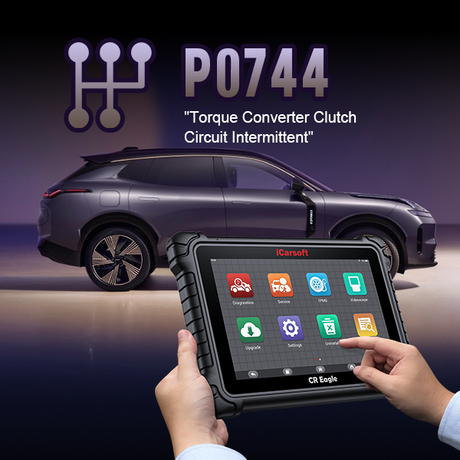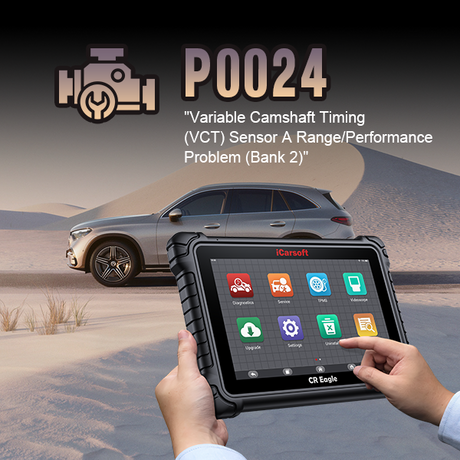The P0753 fault code is a diagnostic trouble code (DTC) signaling an electrical issue with shift solenoid A in an automatic transmission. This code can cause shifting problems, particularly between first and second gears, and may trigger the check engine light. Understanding and resolving this code is crucial for maintaining transmission health. This guide details the P0753 fault code’s meaning, affected vehicles, diagnosis, repair methods, and prevention tips. For more OBD-II code insights, check out our OBD-II Codes Guide.

This image shows the check engine light illuminated, a common indicator of the P0753 fault code.
Table of Contents
- 1. What Does the P0753 Code Indicate?
- 2. Which Vehicles Might Trigger the P0753 Code?
- 3. Understanding the P0753 Code
- 4. Vehicles Prone to the P0753 Code
- 5. Possible Causes of the P0753 Code
- 6. Severity Assessment of the P0753 Code
- 7. Is It Safe to Drive with a P0753 Code?
- 8. Common Symptoms Associated with the P0753 Code
- 9. Diagnosing the P0753 Code
- 10. How to Resolve the P0753 Code
- 11. Preventive Measures for P0753 Issues
- 12. Frequently Asked Questions About the P0753 Code
1. What Does the P0753 Code Indicate?
The P0753 code signals an electrical issue with shift solenoid A in the automatic transmission. This solenoid controls hydraulic pressure to facilitate shifting from first to second gear. When the powertrain control module (PCM) detects an electrical fault (e.g., open circuit, short to ground, or short to power), it sets this code and illuminates the check engine light. This issue is common in vehicles with electronically controlled automatic transmissions.
2. Which Vehicles Might Trigger the P0753 Code?
The P0753 code is a generic OBD-II code that can appear in any vehicle with an automatic transmission, especially those with electronic control systems. Research indicates it’s more common in brands like:
- Ford (e.g., F-150, Explorer)
- Chevrolet (e.g., Silverado, Malibu)
- Toyota (e.g., Camry, RAV4)
- Honda (e.g., Accord, CR-V)
- Dodge (e.g., Ram 1500, Charger)
- Hyundai (e.g., Sonata, Tucson)
- Kia (e.g., Optima, Sportage)
For model-specific details, refer to manufacturer service bulletins or forums like Ford Trucks Forum or Silverado Sierra Forum.

This image shows a shift solenoid in an automatic transmission, often linked to the P0753 fault code.
3. Understanding the P0753 Code
To understand the P0753 code, it’s essential to know how shift solenoid A works. In an automatic transmission, shift solenoids are electromechanical devices that control fluid flow to hydraulic circuits, enabling gear shifts. Shift solenoid A manages the transition from first to second gear by directing hydraulic pressure. The PCM monitors the solenoid’s electrical circuit, and if it detects anomalies (e.g., incorrect voltage), it triggers the P0753 code, potentially causing erratic shifting or transmission failure.
4. Vehicles Prone to the P0753 Code
While any vehicle with an automatic transmission can trigger the P0753 code, certain models are more susceptible due to design or common failure points. Examples include:
- Ford F-150 (2004-2008): Known for shift solenoid issues.
- Chevrolet Silverado (2007-2013): Reports of solenoid-related problems.
- Toyota Camry (2007-2011): Certain transmission models may trigger this code.
- Honda Accord (2003-2007): Early automatic transmission models may experience solenoid issues.
Regular maintenance, such as checking transmission fluid and wiring, can reduce the risk.
5. Possible Causes of the P0753 Code
The P0753 code may be triggered by:
- Faulty Shift Solenoid A: Damage or wear can cause electrical malfunctions.
- Damaged Wiring or Connectors: Corrosion, breaks, or loose connections in the solenoid circuit.
- Low Transmission Fluid Level: Insufficient fluid can impair solenoid operation.
- Dirty or Contaminated Fluid: Debris or old fluid may clog hydraulic passages.
- Clogged Transmission Filter: A blocked filter restricts fluid flow, affecting solenoid performance.
- Faulty PCM: Rare, but a malfunctioning PCM may misinterpret solenoid signals.
- Internal Transmission Issues: Severe problems, like valve body failure, may contribute.
6. Severity Assessment of the P0753 Code
The severity of the P0753 code depends on the root cause:
- Minor Case: Loose connections or minor wiring issues may allow limited driving, though shifts may feel rough.
- Severe Case: Complete solenoid failure or internal transmission damage can prevent shifting, rendering the vehicle undrivable. Immediate repair is needed to avoid further damage.
7. Is It Safe to Drive with a P0753 Code?
- Minor Fault: If shifting is still possible, short drives to a repair shop may be safe, but monitor for worsening symptoms.
- Severe Fault: If the transmission is stuck in one gear, driving is unsafe and may cause costly damage.
8. Common Symptoms Associated with the P0753 Code
Symptoms of the P0753 code include:
- Check Engine Light: The malfunction indicator light (MIL) activates.
- Delayed or Erratic Shifting: Hesitation or roughness, especially between first and second gears.
- Inability to Start: In severe cases, the vehicle may not start if the PCM detects critical issues.
- Transmission Slipping: The vehicle may feel like it’s slipping out of gear.
- Harsh Shifting: Shifts may feel abrupt or jarring.
9. Diagnosing the P0753 Code
Diagnosing the P0753 code involves:
- Preliminary Check: Use an OBD-II scanner to confirm the P0753 code and check for related codes (e.g., P0750, P0751).
- Visual Inspection: Inspect shift solenoid A’s wiring and connectors for damage, corrosion, or loose connections.
- Functional Testing: Test the solenoid and related components per manufacturer specifications.
- Sensor Checks: Verify sensor signals to identify discrepancies.
- Live Data Scan: Use a scan tool to monitor PCM inputs from the solenoid circuit during driving.
Tools Needed for DIY Diagnosis of the P0753 Code
To effectively diagnose and potentially repair the P0753 code yourself, you’ll need the following tools and resources:
-
OBD-II Scanner: Essential for retrieving diagnostic trouble codes like P0753 from the vehicle’s computer. We highly recommend the iCarsoft CR Max, a professional-grade OBD-II scanner ideal for diagnosing P0753 and other transmission issues. Key features include:
- Quick Setup: Supports USB2.0, Wi-Fi, and OBD-II connections, with pre-installed software for immediate use.
- Comprehensive Diagnostics: Accesses engine, transmission, ABS, and SRS systems, offering DTC lookup, live data, freeze frame, and I/M readiness.
- 49+ Maintenance Services: Includes oil reset, EPB reset, DPF calibration, and TPMS reset, useful for transmission-related maintenance.
- Full Bi-Directional Control: Performs active tests like solenoid tests, ABS pump motor tests, and throttle position actuator tests for precise diagnosis.
- 4-in-1 Live Data: Displays diagnostic data in analog, text, graph, or progress bar formats, with playback and printing capabilities.
- High-Quality Hardware: Features a 7-inch LCD touchscreen (1024x600), Android 8.1, quad-core 1.3GHz processor, 32GB memory, and a 5-hour battery life.
- Broad Compatibility: Supports over 10,000 vehicle models (post-1996, OBD-II/EOBD compliant) and 15+ languages, including English and Spanish.
- Lifetime Free Updates: Ensures the tool stays current with new models and bug fixes.
- Multimeter: A versatile tool for measuring voltage, current, and resistance to diagnose electrical issues in the solenoid circuit.
- Vehicle-Specific Technical Manual: Provides detailed information on wiring diagrams, component locations, and diagnostic procedures. Available online or at auto parts stores.
- Basic Mechanical Knowledge: Understanding electrical systems and transmission components aids effective troubleshooting.

This image shows the iCarsoft CR Max, a powerful tool for diagnosing the P0753 fault code.
10. How to Resolve the P0753 Code
Resolving the P0753 code involves:
- Repair or Replace Wiring: Fix damaged or corroded wires and connectors.
- Replace Shift Solenoid A: Install a new solenoid if it’s faulty.
- Replace Fluid and Filter: Flush the system and replace the transmission filter to ensure smooth fluid flow.
- Repair or Replace Valve Body: Address internal transmission issues if present.
- Reprogram or Replace PCM: If the PCM is faulty (rare), it may need reprogramming or replacement.
- Clear Fault Codes: Use an OBD-II scanner to clear codes after repairs.
11. Preventive Measures for P0753 Issues
To prevent P0753 issues:
- Regular Maintenance: Check transmission fluid levels and condition regularly.
- Inspect Wiring: Look for signs of wear or damage during routine maintenance.
- Use Quality Parts: Opt for high-quality, OEM-equivalent components.
- Follow Guidelines: Adhere to manufacturer maintenance schedules.
12. Frequently Asked Questions About the P0753 Code
- What does the P0753 code mean?
It indicates an electrical issue with shift solenoid A, affecting gear shifts in the transmission.
- Can I drive with a P0753 code?
Not recommended, especially if shifting is affected, as it may cause further transmission damage.
- How much does it cost to fix?
Costs range from $100 to $500, depending on whether it’s a solenoid replacement or additional repairs.
- Is P0753 related to other codes?
Yes, it may appear with codes like P0750 (solenoid malfunction) or P0730 (incorrect gear ratio).
- How do I prevent P0753?
Regular transmission maintenance, including fluid changes and wiring checks, can help.
- Can low transmission fluid cause P0753?
Yes, low fluid levels may impair solenoid operation.
- What if P0753 returns after repair?
Recheck connections, test components, and seek professional diagnostics if needed.
Last Updated: May 13, 2025
This article has been updated with additional vehicle examples and expanded FAQs based on reader feedback.












